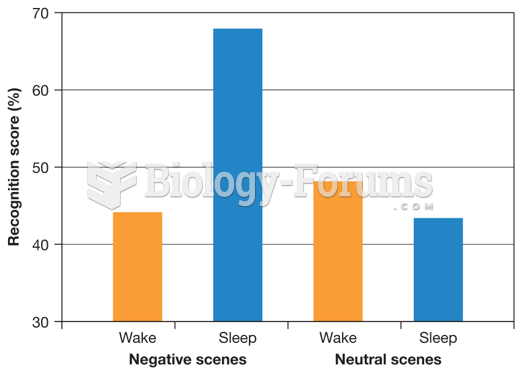Answer to Question 1
Correct Answer: 2
Rationale 1: The limbic system is a group of structures deep in the brain responsible for emotional expression, learning, and memory.
Rationale 2: The cerebrum is the thinking part of the brain responsible for perception, speech, conscious motor movement, movement of skeletal muscles, memory, and smell. Focal abnormalities, often the result of stroke, occur in specific regions and can affect a single brain function. Generalized disorders of the cerebrum affect widespread areas or multiple regions.
Rationale 3: The cerebellum controls muscle movement, balance, posture, and tone. It is involved in learning the fine motor skills that make muscular movements smooth.
Rationale 4: The thalamus is the major relay center in the brain and sends sensory information such as sounds, sights, pain, touch, and temperature to the cerebral cortex.
Global Rationale: The cerebrum is the thinking part of the brain responsible for perception, speech, conscious motor movement, movement of skeletal muscles, memory, and smell. Focal abnormalities, often the result of stroke, occur in specific regions and can affect a single brain function. Generalized disorders of the cerebrum affect widespread areas or multiple regions. The limbic system is a group of structures deep in the brain responsible for emotional expression, learning, and memory. The cerebellum controls muscle movement, balance, posture, and tone. It is involved in learning the fine motor skills that make muscular movements smooth. The thalamus is the major relay center in the brain and sends sensory information such as sounds, sights, pain, touch, and temperature to the cerebral cortex.
Answer to Question 2
Correct Answer: 1,2,3,4
Rationale 1: In some cases, the firing of neurons is inhibited.
Rationale 2: Synapses within the CNS operate by an electrical impulse releasing a neurotransmitter to activate a receptor neuron on the opposite side. In some cases, the electrical impulse inhibits the release of the neurotransmitter.
Rationale 3: In some cases, there is release of an inhibitory neurotransmitter that suppresses neuronal conduction.
Rationale 4: The neuron is the primary functional cell for communicating messages through conduction of an action potential.
Rationale 5: The neuron is the primary functioning cell within the nervous system.
Global Rationale: In some cases, the firing of neurons is inhibited. Synapses within the CNS operate by an electrical impulse releasing a neurotransmitter to activate a receptor neuron on the opposite side. In some cases, the electrical impulse inhibits the release of the neurotransmitter. In some cases, there is release of an inhibitory neurotransmitter that suppresses neuronal conduction. The neuron is the primary functional cell for communicating messages through conduction of an action potential. The neuron is the primary functioning cell within the nervous system.







